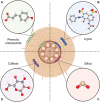The genetic basis of plants' battle against witchweeds: linking immune responses to distinct resistance mechanisms
- PMID: 37702012
- PMCID: PMC10498022
- DOI: 10.1093/jxb/erad305
The genetic basis of plants' battle against witchweeds: linking immune responses to distinct resistance mechanisms
Abstract
This article comments on:
Mutinda S, Mobegi FM, Hale B, Dayou O, Ateka E, Wijeratne A, Wicke S, Bellis ES, Runo S. 2023. Resolving intergenotypic Striga resistance in sorghum. Journal of Experimental Botany 74, 5294–5306.
Keywords: Striga; Cell type-specific defence; cell wall-based resistance; hypersensitive response; inducible defence; lignin; parasitic plants; post-attachment resistance.
Conflict of interest statement
The authors declare that no commercial or financial relationships were present during the research that could be perceived as a potential conflict of interest.
Figures


Similar articles
-
Mechanisms of pre-attachment Striga resistance in sorghum through genome-wide association studies.Mol Genet Genomics. 2022 May;297(3):751-762. doi: 10.1007/s00438-022-01882-6. Epub 2022 Mar 19. Mol Genet Genomics. 2022. PMID: 35305146
-
Host plant resistance to parasitic weeds; recent progress and bottlenecks.Curr Opin Plant Biol. 2010 Aug;13(4):478-84. doi: 10.1016/j.pbi.2010.04.011. Epub 2010 Jun 2. Curr Opin Plant Biol. 2010. PMID: 20627804 Review.
-
GWAS provides biological insights into mechanisms of the parasitic plant (Striga) resistance in sorghum.BMC Plant Biol. 2021 Aug 21;21(1):392. doi: 10.1186/s12870-021-03155-7. BMC Plant Biol. 2021. PMID: 34418971 Free PMC article.
-
Resolving intergenotypic Striga resistance in sorghum.J Exp Bot. 2023 Sep 13;74(17):5294-5306. doi: 10.1093/jxb/erad210. J Exp Bot. 2023. PMID: 37260405 Free PMC article.
-
Molecular Dialog Between Parasitic Plants and Their Hosts.Annu Rev Phytopathol. 2019 Aug 25;57:279-299. doi: 10.1146/annurev-phyto-082718-100043. Epub 2019 Jun 21. Annu Rev Phytopathol. 2019. PMID: 31226021 Review.
References
-
- Abdullahi WM, Dianda M, Boukar O, et al. . 2022. Integrated management of Striga gesnerioides in cowpea using resistant varieties, improved crop nutrition and rhizobium inoculants. Plant and Soil 473, 197–213.
-
- Bacete L, Mélida H, Miedes E, Molina A.. 2018. Plant cell wall-mediated immunity: cell wall changes trigger disease resistance responses. The Plant Journal 93, 614–636. - PubMed
-
- Bàrberi P. 2019. Ecological weed management in Sub-Saharan Africa: prospects and implications on other agroecosystem services. Advances in Agronomy 156, 219–264.
-
- Bouwmeester HJ, Roux C, Lopez-Raez JA, Bécard G.. 2007. Rhizosphere communication of plants, parasitic plants and AM fungi. Trends in Plant Science 12, 224–230. - PubMed

